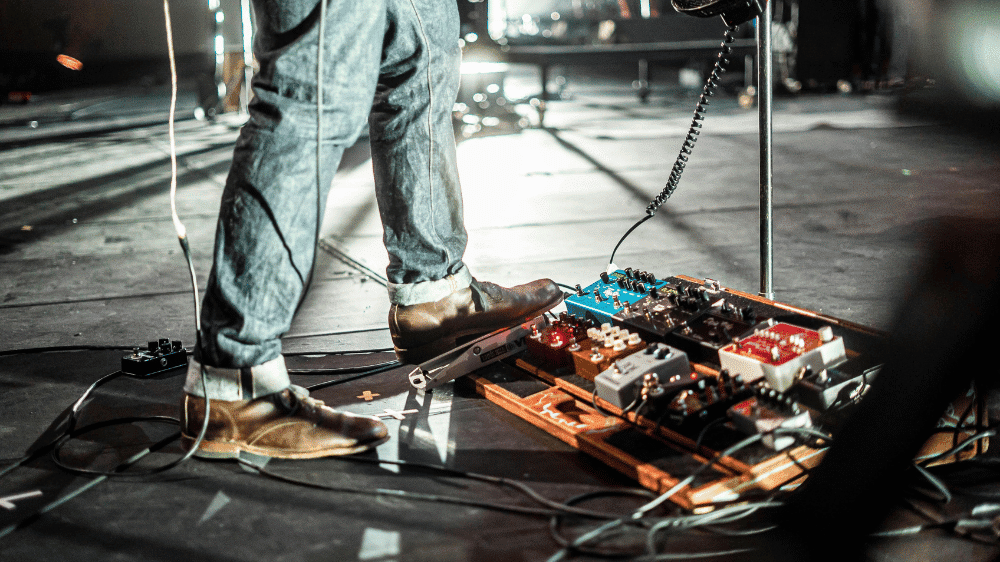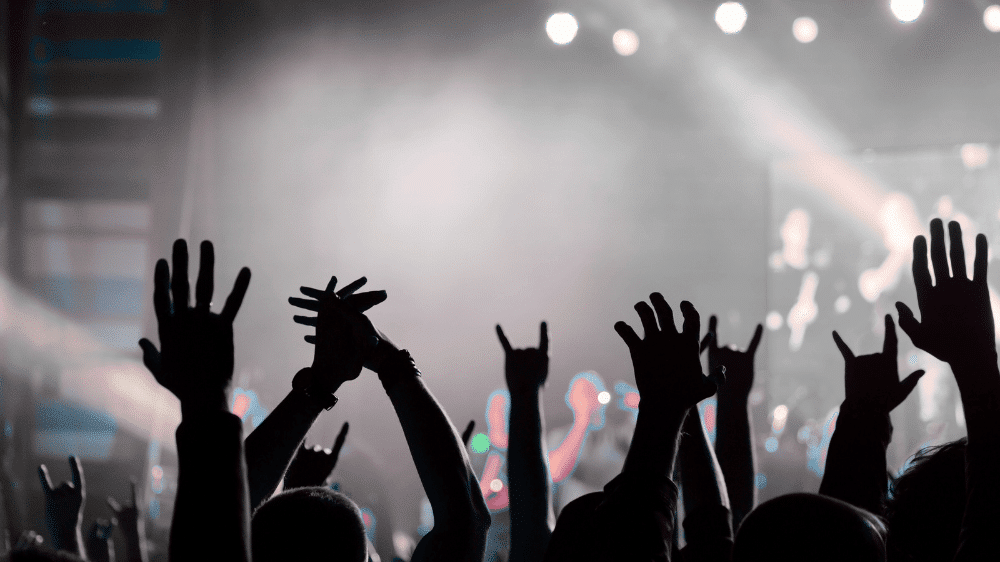Quick Answer: Yes, it’s perfectly fine to leave guitar pedals plugged in with patch cables. Most pedalboard setups stay connected all the time. However, you should always turn off your power supply when not playing.
The exception: if you’re using battery-powered pedals, unplug the input jack to prevent battery drain.

Guitarists often wonder about the best practices for handling their gear, especially when it comes to leaving pedals plugged in between playing sessions.
This common question actually breaks down into two separate concerns: keeping cables physically connected versus leaving the power supply switched on. Each has different implications for your pedal’s longevity and performance.
Let’s explore what you need to know to keep your effects pedals in top condition while making your life easier.
Table of Contents
Leaving Patch Cables Plugged In
The short answer? It’s completely safe to leave patch cables connected to your pedals.
In fact, almost every guitarist with a pedalboard does exactly this. It’s one of the main benefits of having a board in the first place. You set it up once, and you’re ready to play whenever inspiration strikes.
That said, there are a few scenarios where you need to pay attention.
Battery-Powered Pedals: The Input Jack Rule
Here’s the catch that trips up many players: plugging a cable into the input jack of a battery-powered pedal activates its circuit, even when the pedal is switched off.
This happens because most pedals use the input jack as a power switch for the battery. Inserting a cable completes the circuit and starts drawing power. Leave that cable plugged in overnight, and you’ll wake up to a dead battery. Even if you use the best 9V batteries available.
Over time, this adds up to serious money spent on 9V batteries. Worse, if you forget about a pedal for weeks or months, you risk battery leakage that can corrode and permanently damage the internal components.
Simple solution: If you’re using battery power, unplug the input cable when you’re done playing. Just the input. The output jack doesn’t affect battery drain.

Ever wondered why your pedalboard seems to drain batteries faster than expected? Check out How Long Do 9V Batteries Last in Guitar Pedals? to learn what really affects battery life and how to make yours go the distance.
Power Supply Setups: No Worries
If your pedals run on an isolated power supply or daisy chain, leaving cables connected is no issue at all.
The power isn’t activated by the jack connection. It’s controlled by your power supply’s on/off switch.
This is how most modern pedalboards operate.
I keep my entire board connected with patch cables at all times, power it on when I play, and switch it off when I’m done. It’s been this way for years with zero problems.

Physical Wear: Theory vs Reality
You might read that leaving cables plugged in causes mechanical stress on the jacks, leading to oxidation, dirt buildup, or loose connections over time.
In theory, this makes sense. In practice? I’ve never seen it become an actual problem.
Yes, jacks can wear out eventually. Especially if you’re constantly plugging and unplugging cables in a live gigging situation. But leaving a stable pedalboard setup connected at home or in the studio?
The wear is negligible.
If you’re storing pedals for months without use, unplugging cables is good practice. For day-to-day or week-to-week playing, don’t stress about it.

Leaving the Power On
This is where my advice gets more direct: don’t leave your power supply on when you’re not using your pedals.
While it might seem harmless to leave everything powered up, it can shorten the lifespan of your gear and create unnecessary risks.
Component Wear in Analog Pedals
Analog pedals, especially vintage circuits and simpler designs, can experience faster component degradation when left powered on continuously.
Capacitors, resistors, and transistors generate small amounts of heat during operation. Over days, weeks, or months of constant power, this accelerates aging and can lead to tone drift or complete circuit failure.
Digital pedals are generally more robust, but even they benefit from being powered down between sessions. Think of it like leaving your computer running 24/7. Technically possible, but not ideal for long-term health.
Power Surge Risks
Leaving pedals powered on makes them vulnerable during electrical storms, brownouts, or unexpected power surges.
A voltage spike can fry delicate circuitry instantly, turning your favorite overdrive or delay into an expensive paperweight. This is especially risky if you live in an area with unstable power or frequent storms.
Protection options:
- Surge protector power strips
Use a quality surge protector for your pedalboard power supply. It’s cheap insurance. - Master power switch
Get a power strip with an illuminated on/off switch, making it easy to see when your board is powered down. - Unplug during storms
If you know a storm is coming, unplug your power supply entirely for maximum protection.
Real-World Contexts
For bedroom players
You’re probably playing a few times a week, and your pedals sit on a desk or shelf between sessions. Just flip off the power supply when you’re done—it takes two seconds and adds years to your gear’s life.
For gigging musicians
If you’re loading in and out for shows regularly, your pedalboard likely gets powered on only during performances and rehearsals anyway. Just make it a habit to switch off the power supply before packing up.
For studio setups
Many home and commercial studios keep pedalboards connected for weeks at a time. This is fine for the cables, but power down the supply between recording sessions. If you’re tracking daily, at least turn it off overnight.
Best Practices for Pedal Care
Here’s a simple routine that protects your gear without adding hassle:
For Patch Cables
- Leave them connected on pedalboards with isolated power supplies. There’s no benefit to constantly unplugging.
- Unplug the input jack on any battery-powered pedals when not in use to prevent battery drain and leakage.
- Disconnect cables if storing pedals for extended periods (months) to reduce the potential for oxidation.
For Power Supplies
- Turn off your power supply after every playing session. Make it part of your post-playing routine.
- Use a surge protector to guard against voltage spikes and electrical issues.
- Consider a master power strip with an illuminated switch for easy visual confirmation that your board is off.
- Unplug during storms if you live in an area with frequent electrical issues.
Simple Habits, Longer Pedal Life
Leaving your pedals connected with patch cables is not only safe, it’s standard practice for anyone with a pedalboard.
The real key to extending your gear’s lifespan is forming one simple habit: turn off your power supply when you’re done playing.
It takes seconds, costs nothing, and protects your pedals from both gradual component wear and sudden power surge damage. Add a quality surge protector for extra peace of mind, and you’re set.
For battery-powered pedals, just remember to unplug the input jack between sessions. Your wallet and your pedals will thank you.
FAQs
Can you leave pedals plugged in overnight?
Yes, leaving patch cables connected overnight is fine. However, turn off your power supply to prevent unnecessary component wear and protect against power surges. If using battery-powered pedals, unplug the input jack to avoid draining the battery.
Do pedals drain power when switched off?
If powered by a power supply, pedals draw minimal standby power even when switched off, but this is negligible and won’t damage them. Battery-powered pedals, however, will drain the battery whenever a cable is plugged into the input jack, regardless of the pedal’s on/off switch.
Should I unplug my power supply after playing?
You don’t need to unplug the power supply from the wall outlet, but you should turn it off using its switch (or a power strip switch). This protects your pedals from component wear and power surge risks while making it easy to power up again next session.
Is it OK to leave a pedalboard set up all the time?
Absolutely. Most guitarists with pedalboards keep them fully connected with patch cables at all times. Just remember to power down the supply when not in use. This setup is ideal for both home players and studio environments where quick access to your full rig is important.





